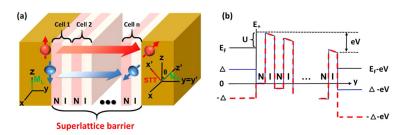Researchers from the National Taiwan University developed a new ultra low power STT-MRAM architecture, called Super Lattice STT-MRAM, or SL-STT-MRAM. The researchers say that SL-STT-MARM simultaneously achieves ultra-high MR ratio, high-speed switching, and low RA.

An SL-STT-MRAM is based on an SL-STT-MTJ, which uses a superlattice barrier to replace the single crystalline (MgO) barrier in traditional STT-MTJ. The superlattice barrier is made of alternating metal and insulator layers, in which only amorphous rather than single crystalline is used in the insulator. The SL-STT-MRAM features higher reliability for repeated writing than compared to traditional MgO based STT-MRAM.
The researchers further say that SL-STT-MRAM production is compatible with traditional STT-MRAM processes, and according to their findings, SL-STT-MTJ can reduce more than 90% switching power and RA value, while the MR ratio and switching speed can be increased more than 10 times.
The researchers are now reaching out to the industry to find partners that will enable further development and hopefully commercialization of the SL-STT-MRAM technology.